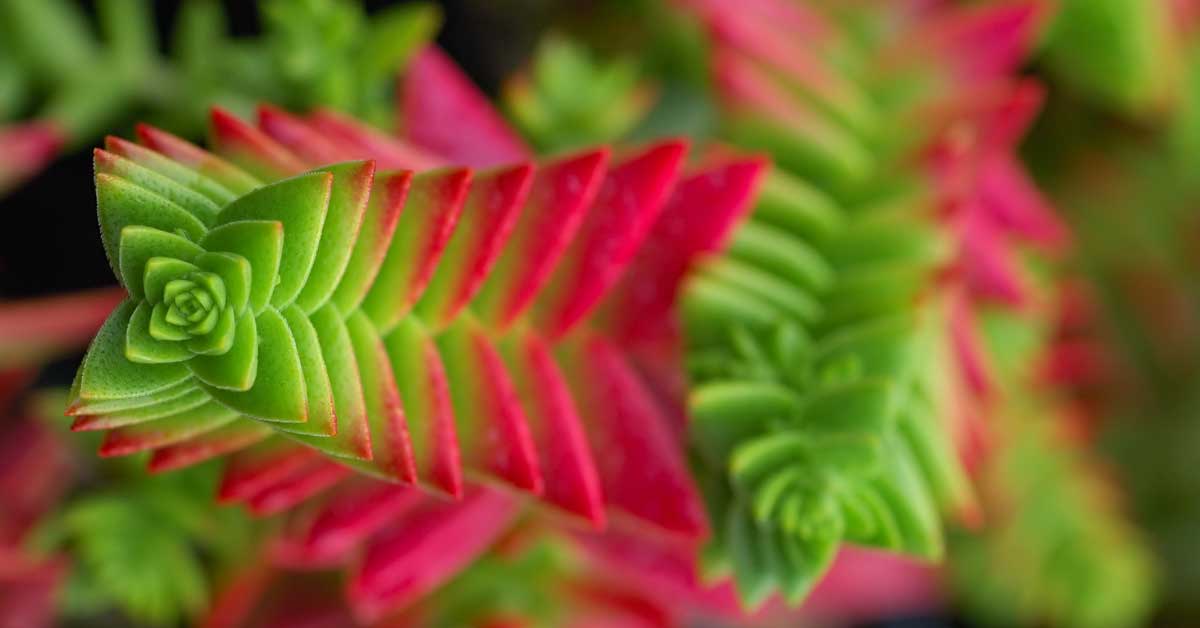Growing succulents is one of my favorite hobbies as a lover of all things gardening. These plants are hardy, beautiful, highly varied, and can tolerate a ton of abuse, or I guess in my case: neglect. Succulents aren’t picky about much of anything, and the string of buttons succulent is no different. This adorable little succulent is a fast grower and spreader and delights my household with yellow flowers in the spring.
In this article, we’ll do a deep dive on growing string of buttons succulents successfully.
Growing string of buttons succulents
Having a deep understanding of a plant when trying to successfully grow it is one of my keys to success with gardening. These basics may not seem all that important at a glance, but the more knowledge of a plant that you have, the more likely you are to be successful. So let’s talk about the fast facts:
- Latin name: Crassula perforata
- Other names: Stacked Crassula, Necklace Vine
- Native to: South Africa
- Invasiveness: Considered invasive
- Sun: Bright, filtered light
- Water: Only after the soil has dried
- Soil: Well Drained, loamy, sand
- Hardiness zone: 9-12
- Plant height: 18 inches
- Bloom period: Spring, yellow flowers
- Container friendly: Yes
- Fertilizer: 10-10-10
- Toxicity: Non-toxic
The string of buttons succulent, sometimes called stacked crassula or necklace vine, is a type of hardy succulent native to South Africa. It is a hot climate plant, thriving in zones 9 through 12. It cannot tolerate frost and must be protected from cold snaps. It is an ideal plant for keeping in a container indoors in an area that receives bright, filtered sunlight. Outdoors, it can tolerate full sun or partial sun.
Crassula perforata is a fast-growing and fast-spreading type of succulent, making it potentially invasive when planted outdoors outside of its native range. Our recommendation is to keep your string of buttons plant in a container that limits its ability to spread. It grows well in well-drained, loamy, sandy soil and produces yellow flowers during the spring. At maximum height, it grows to about 18 inches and does well with a balanced 10-10-10 fertilizer provided once a year during its growing season. This plant is not considered to be toxic to humans or animals.
Water
When it comes to watering, a little bit goes a long way. Succulents don’t need to be flooded with water and will appreciate the opportunity to experience desert-like conditions. Allow your plant’s soil to thoroughly dry before administering more water. During the summer, this is typically around once per week.
Sunlight
String of buttons succulents can do well both indoors and outdoors. When grown indoors, they like bright, direct, filtered sunlight. When grown outdoors, they should be given full sun, a minimum of 6 hours per day. If this is not possible, they can also grow in part shade but made not grow as well, as large, and it may not flower.
Soil & fertilizing
These succulents aren’t too picky about soil, but ideally, they should grow in a medium of well-drained, loamy, sandy soil that doesn’t get waterlogged or soaked all that often. They can be provided a balanced 10-10-10 fertilizer once per year during their growing season.
Invasiveness
While I am not familiar with any official ecological institution labeling the string of buttons succulent as an invasive plant, it is native only to South Africa and can grow and spread very quickly. Any plant with a tendency for quick spread when planted outside of its native range is, in my mind, a plant that should be treated as invasive. For this reason, I strongly recommend growing Crassula perforata in a container that will limit its spread.
Growing string of buttons succulents in containers
String of buttons succulents are ideal candidates for growing in containers and do well when grown both indoors and outdoors. Provide a well-drained, loamy, sandy soil or simply purchase succulent or cactus soil from a local garden center. As the plant grows and spreads, you can increase the size of its pot to help it continue to grow and spread. When growing in a container, provide a balanced 10-10-10 fertilizer once per year during its growing season.
Common problems
The most common issues associated with Crassula perforata has to do with inadequate watering, specifically watering too much. If the plants are too wet for too long, they can develop root rot and slowly begin to die, which is a less than ideal outcome. Only water these succulents when the soil has completely dried out. Don’t overwater them!
Propagating string of buttons succulents
The easiest way to propagate a string of buttons succulent is by taking a cutting of one of its branches and placing the stem in water. Within 2-6 weeks, you will see roots begin to emerge. Once a decent amount of new roots have sprouted, plant the cutting in a succulent growing soil and follow the above guide on growing string of buttons succulents.













